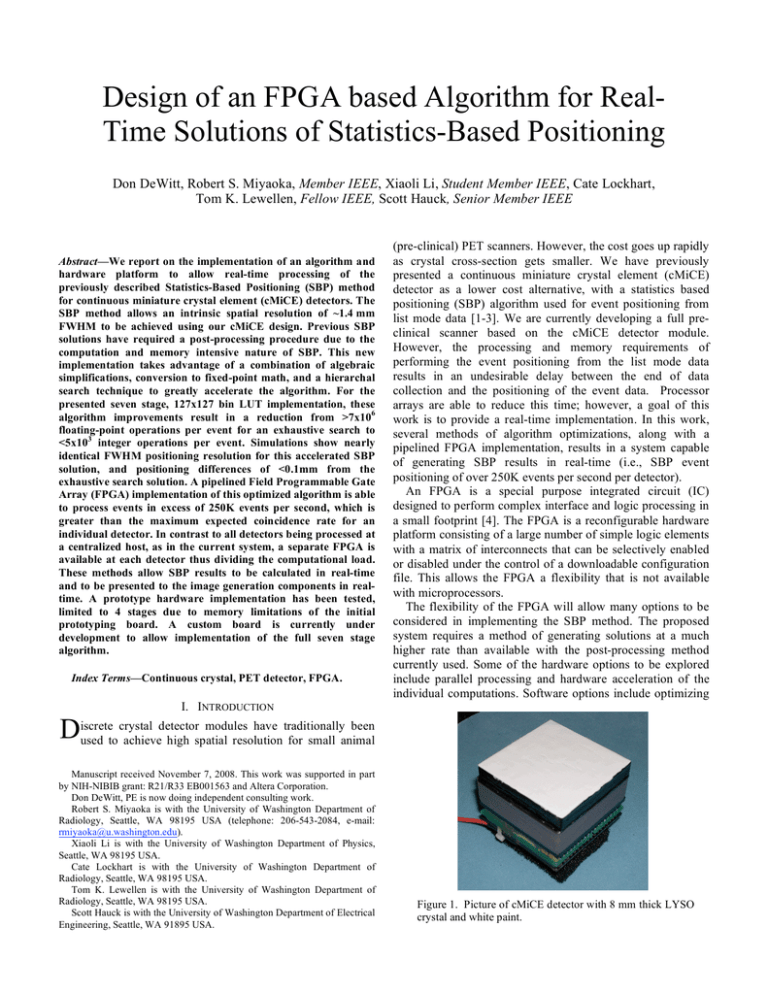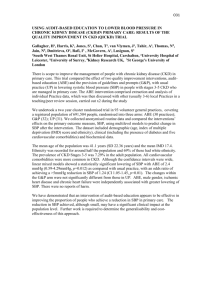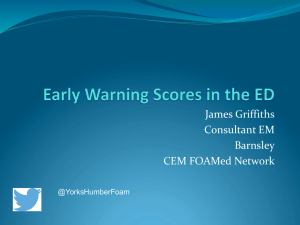Document 10835673
advertisement

Design of an FPGA based Algorithm for RealTime Solutions of Statistics-Based Positioning
Don DeWitt, Robert S. Miyaoka, Member IEEE, Xiaoli Li, Student Member IEEE, Cate Lockhart,
Tom K. Lewellen, Fellow IEEE, Scott Hauck, Senior Member IEEE
Abstract—We report on the implementation of an algorithm and
hardware platform to allow real-time processing of the
previously described Statistics-Based Positioning (SBP) method
for continuous miniature crystal element (cMiCE) detectors. The
SBP method allows an intrinsic spatial resolution of ~1.4 mm
FWHM to be achieved using our cMiCE design. Previous SBP
solutions have required a post-processing procedure due to the
computation and memory intensive nature of SBP. This new
implementation takes advantage of a combination of algebraic
simplifications, conversion to fixed-point math, and a hierarchal
search technique to greatly accelerate the algorithm. For the
presented seven stage, 127x127 bin LUT implementation, these
algorithm improvements result in a reduction from >7x106
floating-point operations per event for an exhaustive search to
<5x103 integer operations per event. Simulations show nearly
identical FWHM positioning resolution for this accelerated SBP
solution, and positioning differences of <0.1mm from the
exhaustive search solution. A pipelined Field Programmable Gate
Array (FPGA) implementation of this optimized algorithm is able
to process events in excess of 250K events per second, which is
greater than the maximum expected coincidence rate for an
individual detector. In contrast to all detectors being processed at
a centralized host, as in the current system, a separate FPGA is
available at each detector thus dividing the computational load.
These methods allow SBP results to be calculated in real-time
and to be presented to the image generation components in realtime. A prototype hardware implementation has been tested,
limited to 4 stages due to memory limitations of the initial
prototyping board. A custom board is currently under
development to allow implementation of the full seven stage
algorithm.
Index Terms—Continuous crystal, PET detector, FPGA.
I. INTRODUCTION
(pre-clinical) PET scanners. However, the cost goes up rapidly
as crystal cross-section gets smaller. We have previously
presented a continuous miniature crystal element (cMiCE)
detector as a lower cost alternative, with a statistics based
positioning (SBP) algorithm used for event positioning from
list mode data [1-3]. We are currently developing a full preclinical scanner based on the cMiCE detector module.
However, the processing and memory requirements of
performing the event positioning from the list mode data
results in an undesirable delay between the end of data
collection and the positioning of the event data. Processor
arrays are able to reduce this time; however, a goal of this
work is to provide a real-time implementation. In this work,
several methods of algorithm optimizations, along with a
pipelined FPGA implementation, results in a system capable
of generating SBP results in real-time (i.e., SBP event
positioning of over 250K events per second per detector).
An FPGA is a special purpose integrated circuit (IC)
designed to perform complex interface and logic processing in
a small footprint [4]. The FPGA is a reconfigurable hardware
platform consisting of a large number of simple logic elements
with a matrix of interconnects that can be selectively enabled
or disabled under the control of a downloadable configuration
file. This allows the FPGA a flexibility that is not available
with microprocessors.
The flexibility of the FPGA will allow many options to be
considered in implementing the SBP method. The proposed
system requires a method of generating solutions at a much
higher rate than available with the post-processing method
currently used. Some of the hardware options to be explored
include parallel processing and hardware acceleration of the
individual computations. Software options include optimizing
crystal detector modules have traditionally been
Discrete
used to achieve high spatial resolution for small animal
Manuscript received November 7, 2008. This work was supported in part
by NIH-NIBIB grant: R21/R33 EB001563 and Altera Corporation.
Don DeWitt, PE is now doing independent consulting work.
Robert S. Miyaoka is with the University of Washington Department of
Radiology, Seattle, WA 98195 USA (telephone: 206-543-2084, e-mail:
rmiyaoka@u.washington.edu).
Xiaoli Li is with the University of Washington Department of Physics,
Seattle, WA 98195 USA.
Cate Lockhart is with the University of Washington Department of
Radiology, Seattle, WA 98195 USA.
Tom K. Lewellen is with the University of Washington Department of
Radiology, Seattle, WA 98195 USA.
Scott Hauck is with the University of Washington Department of Electrical
Engineering, Seattle, WA 91895 USA.
Figure 1. Picture of cMiCE detector with 8 mm thick LYSO
crystal and white paint.
the algorithm performing the computations and conversion
from floating-point to an integer or fixed-point
implementation to reduce the computational complexity.
These methods will be explored in the following sections.
II. MATERIALS AND METHODS
A. cMiCE Detector Module
A cMiCE detector module is pictured in Fig. 1. It is
composed of a 50 mm by 50 mm by 8 mm thick slab of LYSO
(Saint Gobain, Newbury, Ohio) coupled to a 64-channel multianode PMT (H8500, Hamamatsu Photonics K.K., Japan). One
of the 50 mm by 50 mm surfaces was polished. All other
surfaces were roughened. The polished side was coupled to
the PMT using Bicron BC-630 optical grease. The face of the
crystal opposite the PMT was painted white. The side
surfaces of the crystal were painted black to reduce light
reflections off the sides.
B. Statistics-based Positioning Method (SBP)
Suppose the distributions of observing PMT outputs M =
M1, M2, …, Mn for scintillation position x, are independent
normal distributions with mean {µ(x)} and standard deviation
{σ(x)}.
The likelihood function for making any single observation
mi from distribution Mi given x is:
n
L[mi | x ] = !
i =1
' (m ( µ (x ))2 $
1
"
exp%% ( i 2 i
2) i (x ) "#
) i ( x ) 2*
&
(1).
The maximum likelihood estimator of the event position x is
given by:
2
$
'
m
!
µ
x
(
)
i
i
)
(2).
x̂ = arg min & #
+
ln
"
x
i( ) )
& i
x
2" i2 ( x )
&%
)(
(
)
(
)
The SBP method requires that the light response function
versus interaction location be characterized for the detector.
Two SBP look-up tables (LUTs) corresponding to the mean
and variance of the light probability density function (PDF)
versus (x,y) position are created during the characterization
process. The LUTs are 127x127, corresponding to ~0.4 mm
by ~0.4 mm pixels for binning.
For more detailed
explanations about the SBP implementation refer to Joung [1].
C. Equation Simplification
The proposed method to implement SBP within an FPGA
relies upon multiple levels of optimization. The first to be
employed is reducing the number of computations required for
each iteration of the likelihood equation, the central
component of the SBP method. The log likelihood function for
each signal channel can be represented as in Equation 3.
(mi ! µi (x))2
+ ln(" i (x))
2" i2 (x)
(3)
The objective is to manipulate this function to minimize those
numerical operations which are expensive to perform in terms
of time or resources. With the computational resources
available in this project the following guidelines are
employed:
• Adds and subtracts are efficient.
• Multiply is relatively efficient, but should be kept to a
minimum.
• Squares are special cases of multiply, but should also be
minimized.
• Division is very inefficient because it requires an
iterative approach.
• Transcendental functions should be avoided at all costs.
Each iteration of Equation 3 consists of seven operations:
1.
2.
3.
4.
5.
6.
7.
Subtract (E - µ).
Square the result.
Square σ.
Multiply the result by 2.
Divide the result of step 2 by the result of step 4.
Find the natural log of σ.
Add the result of step 7 to the result of step 5.
The transcendental function of step 6 increases the
complexity of this method well beyond the seven operations,
and needs to be eliminated. Also, the division should be
replaced by a multiplication by a pre-computed inverse if
possible. Following the guidelines given above leads to the
simplification shown in Equation 4.
If we let A=µi(x), B=1/(1.414σi(x)) and C=ln(σi(x)),
Equation 3 can be rewritten as Equation 4.
((x ! A) " B)2 + C
(4)
In this simplification, the three variables A, B and C replace
the original µ and σ in the data tables. Variable A is simply
equal to µ. Variables B and C can be pre-calculated by the
host before being stored in the data tables used for this
calculation, saving the time and resources of both the
arithmetic operations and the transcendental function. With
these simplifications, only four operations are required:
1.
2.
3.
4.
Subtract (E - A).
Multiply the results by B.
Square the results.
Add C.
This greatly reduces the computational complexity of each
iteration of the likelihood equation and will be substituted for
the original equation in all of the following uses.
D. Twenty-One channel solution
The original SBP solution summed the log likelihood
equation for each of the 64 channels of the 8x8 sensor.
However, it was found that using channels far from the peak
reduced positioning accuracy. Using the 21 channels
surrounding the peak energy, as shown in Figure 2, led to
better positioning performance. In addition to improving
positioning, this results in a ~3:1 reduction in the number of
operations needed for each solution.
Figure 2. Twenty-one channel masking, centered on the peak energy
channel.
E. Conversion to Fixed-Point
Floating-point calculations are computationally expensive
in an FPGA implementation. Additionally, floating-point
values occupy 4 or more bytes of memory storage per value,
creating an excessive storage requirement. Converting to
integer representations, while retaining the required resolution,
necessitates multiplying by a power of two before the
conversion to move fractional parts of the value into the
resulting integer. Proper management of these multiplication
steps allows the resulting calculations to correctly represent
the relative values of the original results. The advantages of
using integer values are that a smaller number of bits are
required for storage, and integer math operations can be used
for all calculations and comparisons.
space is sampled, centered on the previous best solution. This
process continues iteratively until the solution space is a single
pixel. An advantage of this method is that the early stages of
the search only require access to a small number of the table
values. This allows separate tables for each stage of the
search, without the large storage requirements of multiple
copies of the complete tables.
This algorithm yields a large reduction in the number of
points that need to be sampled. Variations in the number of
sampled points at each iteration were simulated, ranging from
a 2x2 array of samples at each iteration of the search, resulting
in an 8 iteration search in a 127x127 solution space (best case)
to 5x5 samples resulting in a three iteration search. These
require a total of 2*2*8=32 sampled points for the 2x2 search
to 5*5*3=75 points for a 5x5 search.
The optimal solution was found to be a hierarchal search
with 3x3 samples at each iteration, dividing the solution space
to approximately one-quarter of its previous size. An example
of this search on a 63x63 solution space is shown in Figure 4.
This example shows the five iterations necessary to fully
search the 63x63 space. The solution space of each successive
stage is shown by the increasingly smaller box. Within each
solution space, the nine X-Y points to be tested are shown,
centered on the best solution from the preceding stage. The
search concludes with a three by three search at a spacing of
one pixel.
Count( z) = 41
F. Hierarchal Search
An exhaustive search method has the advantage of being
easy to implement and is guaranteed to always find the
absolute minimum solution. It has the disadvantage of being
very inefficient, both in terms of the number of iterations, and
the number of memory accesses to find a solution.
Observation of the solution set, figure 3, made it apparent that
a structured search could be used to converge to a solution
with many fewer iterations.
z, Z
Figure 4. Five iterations of a 3x3 search on a 63x63 solution
space.
Figure 3. The complete solution set for a representative event.
Of the structured searches explored [5], it was found that a
hierarchal search provided the best combination of reduced
iterations and memory usage, allowing memory to be
partitioned in a way that was conducive to a pipelined
implementation. This search functions by finding the solutions
at a number of evenly distributed samples points. The
minimum result from these samples identifies the region
holding the ultimate solution and a new, smaller solution
The regularity of this search allows each level of the search
to consist of an almost identical process, where each iteration
starts with a center point for the search and the spacing
between points to be tested at this iteration. For the 3x3 search
shown, 9 sets of characterization data table values are needed
for the first stage, one for each position to be tested. The next
iteration will consist of potential sample positions at one-half
the spacing, with sets of points centered on each of the
previous stage’s points, with the first stage defaulting to being
centered on the center of the entire data table (see figure 4).
This results in each stages’ data table having approximately
four times the number of testable locations as the previous
stage, but still only a fraction of the overall table, until the last
stage is reached. The last stage is the only stage that needs
access to the entire table. Each iteration will begin with the
best solution from the previous stage as the center point of its
search and will test all points adjacent to it at the current
resolution. As each stage passes its best result to the next
stage, eventually the last stage is reached where the spacing
between adjacent pixels is one. The results of this stage
represent the best solution available for the data table used.
Structuring the search in this way allows points sampled
during each iteration to be independent of calculations
currently underway in other iterations. This can allow
calculations for different events to be pipelined, allowing
multiple stages to be processed simultaneously.
A second advantage of this method is that the storage
requirement for each stage’s data table is reduced for each
iteration prior to the last. Ideally, for n samples, the new
solution space would contain n times as many possible
solutions as the previous iteration. For our example with nine
samples, we would hope for nine times as many potential
sample points at the next iteration. However, experiments
determined that when the final solution was located
approximately midway between two sampled points, this
solution was not always nearest to the best sampled point. The
cause of this was found to be that the solution set is not
completely symmetric and is subject to some solution noise.
To solve this problem, each successive iteration must operate
on a subset that is significantly larger than n times the size of
the previous iteration.
Our solution is to have the solution space dimension at each
stage to be an integer power of 2, minus 1 (2n-1). Constraining
each level to have an odd number of values allows each
solution space to have a pixel in the exact center, with other
X-Y locations spaced at a power of two. A representation of a
simple four stage system is shown in Figure 5. The top row of
figures shows the spacing of the locations that can be tested at
each stage. The bottom row of figures shows how these values
are stored using a compressed addressing scheme where the
unused values are not included in the table for that stage. This
allows the data table at all stages except for the final stage to
be stored in a much smaller memory space. The storage of the
odd number of values is padded with blank values to allow
separate X and Y addresses to access the desired coordinate
without requiring an address calculation. The proper value is
addressed by simply appending the binary representation of
the X location to the Y location. For example, if the desired X
coordinate is 11b and the Y coordinate is 01b, the address of
the desired value is at 1101b. As the solution moves from one
stage to the next, address translations to match the next stage
are accomplished by multiplying the X and Y coordinates by
two. This is accomplished by appending a zero to the binary
address values. For the example above, 11b->110b and 01b>010b, so the resulting address of the same coordinate in the
next stages addressing scheme would be 110010b. This allows
the binary system to do in-stage addressing and next-stage
address translations in zero time.
Stage 1
Stage 2
Stage 3
Stage 4
Figure 5. Compressed storage for data tables.
As the solution progresses, the only information passed
from one stage to the next is the center point on which to base
that stage’s search. Each stage has access to data table
information at twice the resolution as the previous stage, but
will only be accessing values directly adjacent to the center
value, as shown in Figure 6. This is done by sequentially
adding then subtracting one from the values of the center X
and Y positions passed from the previous stage.
In this example, it can be seen that the spacing between
tested locations reduces from four in the 15x15 space, to two
in the 7x7 space, to one pixel as the last 3x3 stage is reached.
Figure 6. Diagram of the last three iterations of a hierarchal
search.
The one pixel spacing of the last stage results in an exhaustive
search of this reduced space.
G. Pipelined Architecture
To attain the desired processing rates for this project,
multiple events must be simultaneously processed. Although
parallel processing paths could easily be formed in the FPGA,
multiple copies of the complete data tables would be required
to support this architecture. Using the search described above,
a pipelined architecture is possible. In this design, each stage
of the hierarchal search is implemented with dedicated
hardware that has exclusive access to a data table
appropriately sized for the stage. As each event’s processing at
one stage is completed, the intermediate results are passed as a
starting point to the successive stage, allowing the next event
to immediately begin processing. This results in multiple
events simultaneously being at various stages of their
processing without requiring multiple complete copies of the
data tables.
H. Memory Division
The characterization tables for each sensor must be
available for solving the likelihood function. The most direct
approach would be to store the tables in the FPGA’s on-chip
Stages 5 - n
Figure 7. Block diagram of FPGA implementation of SBP. The numbered components are defined in section J.
SRAM memory. Processing the events would be simplified
compared to accessing off-chip synchronous dynamic (SD) or
double data rate (DDR) memory. The difficulty with this
method is the large size of the tables. Each of the three tables
requires 16-bit values for each of the 8x8 channels of sensed
data, for 127 possible positions in each of the X and Y axes.
This equates to [3 Tables] x [2 byte values] x [8x8 channels] x
[127x127 possible X-Y locations] or >6 Mbytes. This is well
above the approximately 300 kB to 1.1 MB available in
members of the family of FPGA devices chosen for this
project (i.e., Altera Stratix II or III devices, Altera, San Jose,
CA). Further, future versions of this system are planned that
will require multiple sets of tables to support three
dimensional positioning of a detected event. If it were possible
to create the current solution using only internal memory, this
project’s work would not be reusable for future designs that
will certainly require access to external memory.
The design employs a mix of FPGA internal memory and
high-speed external memory. This allows all the small data
tables required by the early stages of the process to have
individual data and address busses, allowing parallel access by
the different stages. The largest data tables are kept in external
memories where adequate storage is available. Because most
of the processing is done in the multiple earlier stages,
memory bandwidth requirements are significantly reduced to
the external memories.
I. Input Buffering
Although the average event rate is expected to be 250K
events per second or less, because of the random nature of
positron decay, instantaneous peak rates as high as 2 times this
value are expected. An input FIFO buffer allows data
collection at up to the peak rate, and delivery to the SBP
algorithm at no more than the designed rate.
J. Prototype Implementation
A block-diagram of the system design is shown in Figure 7.
The numbered components of this system are:
1. An interface to the incoming data. In the prototype system
this is previously collected data that is downloaded, stored
in local memory and sequenced into the system to
simulate actual data collection.
2. A FIFO buffer. This allows the randomly occurring
samples to be collected at up to the peak rate, but
processed at their average rate. This will be necessary in
the target system because the events occur randomly and
may momentarily occur at faster rates than the SBP
algorithm can process them. This buffer allows them to be
stored and dispensed to the algorithm at a lower average
rate.
3. The Fetch Event block gets the next available event from
the FIFO and structures it for use in the SBP calculations.
4. This block determines the row and column of the sensor
with the peak energy. This is made available to the SBP
algorithm to allow the 21-cell version of the SBP
algorithm to calculate the proper channels to process for
the corresponding event.
5. The values of an event are stored locally at each stage so
that they can be accessed for the calculations required at
that stage. As processing of a particular stage completes,
the values are passed along to the next stage. Doublebuffering is used to allow each stage to transfer the values
to the next stage before either stage has completed its
current calculations. This allows the transfer of data to
overlap the calculations.
6. Row center (Rc), Column center (Cc). The values of the
row and column centers for the 21-cell solution are also
stored locally at each stage.
7. The characterization tables for each stage holds the data
required for the SBP algorithm.
8.
The SBP calculations to determine the likelihood values
are performed here. As each X-Y position is tested, if the
sum is less than previously tested positions the X-Y value
is saved. When the last X-Y position is tested, the X-Y
position of the position with the lowest sum is made
available to the next stage as the center X-Y position (XcYc) of the positions to be tested.
9. Increment dX, and dY. This sequences each step of the
algorithm through the proper X and Y locations for each
X and Y position to be tested. The dX (delta X) is added
to the Xc (X center) to determine proper position on which
to perform the likelihood calculation. The Y values are
computed in the same way. Additional timing signals are
generated here to signify occurrences of the first X-Y and
last X-Y tested to coordinate resetting values at the
beginning of calculations and transferring values at the
end of calculations.
10. Increment dRow and dCol. This sequences the likelihood
calculation through all the rows and columns of the 21cell solution. Similar to the X-Y locations, the delta
values for the row and column are added to the center
location of the 21 cells to be included in the calculation.
Additional timing signals are generated here to signify
occurrences of the first row/column and last row/column
to coordinate resetting values at the beginning of each
iteration of the likelihood function.
The results show that over 90% of the events show no error
and over 99% are within 1.4 pixels (actually 0.3 mm),
representing all the pixels immediately adjacent to the
reference pixel. Note that in this comparison, diagonal pixels
are represented by the Euclidean distance. A large portion of
the <1% remaining errors are the results of the solutions of
background noise, seen as the scattering of points across the
surface. Many of these events have solution sets that do not
allow an accurate solution regardless of the method used.
These errors do not noticeably impact the quality of the
resulting image.
A four stage system has been tested in hardware and a seven
stage system is currently being developed. An integer based
simulation extending the results of the four stage hardware
was developed to compare solutions with the reference
floating-point SBP solutions.
Positioning results using
floating point and fixed-point calculations, illustrated in figure
9, show no visible difference in performance. The results for
fifteen tested experimental data sets are shown in Table 1.
Data collected near the edge of the detectors (i.e., data set 1
and 2) showed the largest differences from the reference
floating-point calculations. Points further from the edge
showed little to no error.
Forths -> 4/16
100
95
90
85
80
75
IV. RESULTS
To test the accuracy of our design implementation,
simulations were run where the results of a large number of
sampled locations were compared to the results of the
exhaustive search on an event-by-event basis. To summarize
the cumulative effect of these comparisons, a histogram
showing the distance error between the positions calculated
using the exhaustive search and the same positions calculated
using the hierarchal search was prepared. The worst case
results were for a 2x2 search. These results are shown in
Figure 8.
70
65
Percent
When the computations at each stage are complete the event
data, the row and column centers, and the newly computed X
and Y centers are passed to the next stage. Each stage operates
identically to the previous stage except that the data tables are
larger at each successive stage. The number of potential X-Y
positions that will be tested for each event at each stage are the
same, but they can have a larger number of potential Xc and
Yc positions on which to center this stage of the search. This is
accommodated by appending a single bit to the least
significant end of the Xc and Yc values as they are transferred
to the next stage. This also explains the apparent lack of a first
stage. The first stage data table would consist of only one
location, so the results of this computation are known without
requiring any computations. The address of this value (0,0) are
passed to stage two and used as the starting point for that
stage. The result at each stage is the X-Y location of the best
fit to the characterization data to the precision achieved at that
stage. The result of the final stage is the value that represents
the highest precision available in this implementation.
60
55
50
n = 1000000
45
40
35
30
25
20
15
10
5
0
0
0.5
1
1.5
2
2.5
3
3.5
4
Millimeters
round( 4 !10!.1)
round( 4 !10!.5)
round( 4 !10!1.4)
WWr , 1
r,1
" of
" WWbetween
" WWr , 1
Figure 8. Histogram
distance errors (mm)
exhaustive
r=0
r=0
r=0
= 90.6 %
= 98.4 %
= 99.2 %
and hierarchal searches.
rows( Q)
rows( Q)
rows( Q)
Table 1. Comparison of reference (original SBP implementation) and
optimized calculation (FPGA implementation) FWHM values.
Reference
Optimized
Calculation
Calculation
data-set n
FWHM (mm)FWHM (mm)delta (mm)
1
16793
2.16
1.93
-0.23
2
18796
1.90
2.33
0.43
3
19540
1.41
1.43
0.02
4
19560
1.28
1.31
0.03
5
18921
1.19
1.10
-0.09
6
13699
1.46
1.48
0.02
7
14136
1.25
1.43
0.18
8
13100
1.35
1.33
-0.02
9
13223
1.19
1.23
0.04
10
14209
1.37
1.30
-0.07
11
12584
1.32
1.35
0.03
12
14043
1.46
1.43
-0.03
13
13545
1.54
1.54
0.00
14
12920
1.56
1.59
0.03
15
13690
1.25
1.27
0.02
Average
1.45
1.47
0.02
The throughput of the system is defined as the rate at which
new solutions are completed. In this pipelined design, it is
4.5
equal to the time for one stage to complete. For the current
design, each stage requires nine summations of the 21-channel
solution, each being able to complete in one clock cycle.
Additionally, three clock cycles are required for determining
the minimum of the nine summations and transferring this
value to the next stage. This results in a new event starting,
and one completing, every 192 clock cycles. At the designed
clock rate of 70 MHz, this results in a throughput of >360k
events per second.
The latency is defined as the time from the acceptance of
the data to the presentation of the processed SBP position to
the host. Disregarding the time required to pass the detector
data through the FIFO and the time to pass the results to the
host, this is equivalent to the combined time of all the stages.
For a complete seven stage system, this would be seven times
192 clock cycles at 70 MHz, or approximately 20 µS.
File = "Pos.35.312_59.844"
h
Figure 9. Resulting point source image for floating point (left)
and fixed-point (right) calculations.
V. CONCLUSIONS
This study showed that optimizations to the SBP algorithm
to allow real-time implementation on an FPGA can be made
without adversely affecting the accuracy of the results. These
optimizations included algebraic manipulation of the SBP
equation to allow higher speed computations, reduction of the
number of cells required for each solution, conversion to
fixed-point math, and the use of a structured search algorithm.
The hierarchal search method developed as part of this
study, in addition to greatly increasing the search speed over
current implementations, allows the memory requirements of
the SBP method to be distributed across multiple stages, and
across both internal and external memories. This allows a
multi-stage pipeline solution to be used. This was a significant
factor in increasing the speed of the SBP solution.
Collectively, these optimizations allow an accelerated SBP
solution to be found at a rate that exceeds the maximum
expected average event rate, to an accuracy that compares
satisfactorily with existing methods. This project has shown
that it is possible to use an FPGA implementation of SBP to
facilitate real-time processing of event data for a PET system.
This is a major step forward in the development of a research
preclinical PET system being built at the University of
Washington.
REFERENCES
[1]
J Joung, R.S. Miyaoka, T.K. Lewellen, “CMiCE: A high resolution
animal PET using continuous LSO with a statistics based positioning
[2]
[3]
[4]
[5]
scheme,” Nucl. Instrum. Meth. Phys. Res. A, vol. 489, no. 1-3, pp. 584589, Aug. 2002.
T. Ling, K. Lee, R.S. Miyaoka, “Performance comparisons of
continuous miniature crystal element (cMiCE) detectors,” IEEE Trans.
Nucl. Sci., vol. 53, pp. 2513-2518, 2006.
T. Ling, T.K. Lewellen, R.S. Miyaoka, “Depth of interaction decoding
for a continuous crystal detector,” Phys. Med. Biol., vol. 52, pp. 22132228, April 2007.
S. Hauck, A. DeHon (editors), “Reconfigurable Computing: The Theory
and
Practice
of
FPGA-based
Computation”,
Morgan
Kaufmann/Elsevier, 2008.
D. DeWitt, “An FPGA Implementation of Statistical Based Positioning
for Positron Emission Tomography”, Master’s thesis, Department of
Electrical Engineering, University of Washington, 2008.





